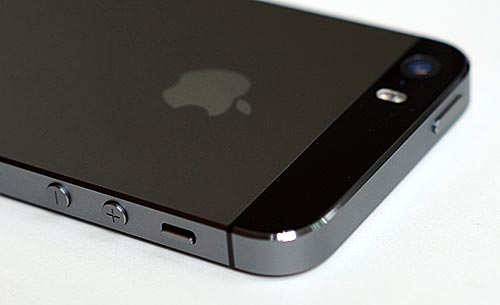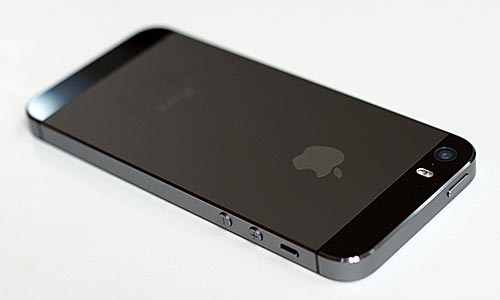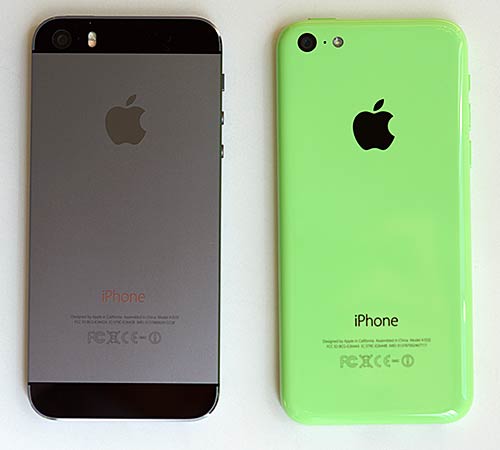Performance
Not that the iPhone 5 felt slow, but the iPhone 5s makes it seem obsolete thanks to the new Apple A7 CPU that benchmarks twice as fast. We sometimes fault Android for chasing feeds and speeds rather than features that really matter, and Apple's equally guilty here. Not to come down hard on a company that's made this insane kind of processing leap; that's great. It's just not the first thing you'll notice when using the phone because the A6 hadn't yet grown long in the tooth. That said, iOS app developers are a crafty and creative bunch, and I'm sure they'll find use for all those CPU and GPU cycles, especially when it comes to 3D games. The new A7 will likely be more interesting in the iPad 5 since that tablet has become a go to device for mobile gaming and it sports an extremely high resolution display that demands more from the processor and graphics. I am impressed that Apple manages to get so much performance from the A7 when it's clocked at just 1.3GHz and has two cores. Lesson learned: clocks speeds and the number of cores doesn't always indicate performance levels. The 2.26GHz Snapdragon with four cores doesn't beat the A7 in benchmarks.
Where will you notice faster CPU? HDR photos are quick to capture and process. The phone can easily handle switching between slo-mo and standard motion video recording. Big games launch up to twice as fast.
Benchmarks
Geekbench 3: 1363 single core / 2404 multi-core
3DMark, Ice Storm test (extreme): 9951 (graphics 10,968, physics 8050). Demo: 47 fps
Sunspider: 422
| |
Geekbench 3 |
3DMark Ice Storm Extreme |
Sunspider JavaScript Test |
| iPhone 5s |
1380/2547 |
14,966 |
398 |
| iPhone 6 |
1614/2900 |
17,190 |
346 |
| iPhone 6 Plus |
1608/2877 |
17,601 |
363 |
| iPhone 5c |
692/1245 |
3306 |
713 |
| iPhone 5 |
691/1289 |
N/A |
901 |
| LG G2 |
852/2137 |
9803 |
823 |
| Moto X |
677/1261 |
6800 |
1097 |
| Samsung Galaxy S4 |
689/1901 |
6858 |
826 |
| HTC One |
633/1787 |
6719 |
1155 |
| Sony Xperia Z |
489/1553 |
6353 |
1306 |
Touch ID
Thanks to the NSA's recently exposed shenanigans, Apple's new fingerprint sensor was greeted with paranoia rather than joy. Poor Apple, how could they have known? I am neither a wildly important person nor particularly paranoid, so I'm more than pleased with Touch ID. For the record, Apple says they don't store your fingerprints on their servers and only snippets of data about your fingerprint are stored encrypted on a chip inside the phone. Yes, serious bad guys can hack it by reproducing your fingerprint, but that requires training, $1,000 worth of equipment, a clean copy of your non-smeared fingerprint (and it has to be the finger you're using with Touch ID) and many hours of time. Everyday crooks aren't going to do this for your iPhone or mine. They'll simply use other methods to wipe it and sell the phone. In other words, they're interested in the resale value of your phone, not your data. If you're a prime minister or Justin Bieber, these James Bond style masterminds might bother.
Biometric fingerprint sensors and TPM (Trusted Platform Module chips) aren't new. They've been on business laptops and even the Motorola Atrix for some time. Apple rarely starts a new tech, they prefer to take an existing technology and perfect it, making it something that anyone could use and enjoy. Touch ID is like that: it's very easy to set up and it works 95% of the time. If your finger is wet or greasy with pizza, it won't work. If you place your finger on the sensor at a funny angle, it will work. You'll teach it your fingerprint (up to five fingers--be they yours, your spouse's or whomever you like), assign a PIN and you're ready to go.
When the phone is rebooted, it will ask for your PIN as a security measure. If you fail the fingerprint scan five times, you'll have to enter your PIN, so don't forget it. To make changes to Touch ID settings, you'll have to enter your PIN. To unlock the phone, you'll press the home button, release it and let your finger linger a second until it's scanned. The home button is the scanner and it's covered in sapphire crystal, which is a very hard and durable material. That should prevent scratches that might render the scanner ineffective.
If you'd rather not use Touch ID you don't have to. You don't have to use a PIN either. I have always wanted to secure my phone, but I hated the time it took to enter a PIN every time I wanted to use the phone. This is fast and reliable, so I'm now using the security I'd always wanted on my phone.
You can use Touch ID to unlock the phone from sleep and to make iTunes purchases. Every one in a while the phone will still ask you to enter your password for iTunes purchases, as a safeguard. Apple hasn't opened it up to third party developers yet, and I'm glad they're cautious exposing the feature to others. I trust Apple pretty well, but small developers and their software? I'm not so sure. Of course, Apple could put a wall between the Touch ID system and third party apps so the app makes a request to Touch ID and gets a simple "yes" or "no" rather than seeing any data about you. Time will tell how this unfolds.
Camera
Both the front 1.2MP FaceTime camera and rear 8MP iSight camera get bigger pixels (1.5u vs. the iPhone 5 and 5c's 1.4u on the rear iSight camera) for capturing more detail and color with less noise, particularly in low light. This is the same route HTC went with the HTC One and its 4MP equivalent rear camera. The One uses even larger pixels, but the camera resolution is half the conventional low end norm for camera phones these days, and that hurts when using the photos for larger placements on a web page or when printing. Apple went with the right balance of megapixels (we're not giving up any compared to the iPhone 5) vs. pixel size to please most folks. The rear lens is also faster: f/2.2 vs. the iPhone 5 and iPhone 5c's f/2.4 lens. The iPhone 5s uses a 5 element lens (made of plastic) and it has digital image stabilization (we'd love to see Apple move to optical image stabilization, but there's probably not enough room in the iPhone's small chassis). Lastly, the True Tone flash is a combo of one white and one amber LED flash that improves color balance when doing flash photography. In practice, it has improved flash photos in our tests.
Are photos better? Markedly so, and that's impressive since the iPhone 5, despite the lack of in-camera settings and features, was one of the better shooters among smartphones. Colors and exposure are the standouts, particularly in low light scenes. Details like our cat's fur in a dim room are impressive and there's less noise. Nighttime photography is particularly improved: photos that were mostly murky black on the iPhone 5 now have content. I suspect the camera will be one of the most popular improvements.
The front camera is also improved, and FaceTime video chats no longer look like blocky impressionism. Our video chat partners could see strands of hair and the sharply lined rim of eyeglasses, and colors are improved as well. Both front and rear cameras have backside illuminated sensors and they can record video. Unlike the Samsung Galaxy S4 and LG G2, you can't record using front and rear cameras simultaneously. You can shoot photos while recording video, as a consolation.
iOS 7 brings new camera features, though the UI is still very simple. You have control over the flash and HDR, a selection of live Instagram-like effects, and there's a slider on the bottom where you can choose from photo, square photo, panorama, video and slo-mo video. Slow motion video is recorded at 720p/120 fps rather than the usual 1080p/30 fps. The beginning and end of slo-mo video play at standard speed, and that makes for a more dramatic effect. Oddly, if you use a USB or WiFi sync to transfer slo-mo videos to your computer, they'll simply play at standard speed. If you upload them to YouTube or email them, the slo-mo is intact. This means you'll have to fudge getting slo-mo videos onto your computer by emailing them to yourself (at least for now). If you AirDrop the videos to other iOS devices, they'll maintain the slow motion feature. Only the iPhone can record slow motion video as of this writing.
Battery Life
Apple slightly increased battery capacity to 1560 mAh on the iPhone 5s. Since the new CPU likely consumes a little more power, we haven't noticed much change from iPhone 5 runtimes. That means the phone is competitive with other smartphones on the market, but it doesn't pull ahead. Again, Apple's insistence on staying with a very small form factor limits them; there's only so much room for a battery inside and the iPhone's is smaller than most big Android phone batteries. Of course, the iPhone 5s doesn't have to power a big 5" display or full HD resolution, so it doesn't need as big a battery.
In a real life setting the iPhone 5s lasted through the day with moderate use that included 30 minutes of gaming, phone calls, push email (including the Gmail app), listening to music with the screen off while streaming to an AirPlay speaker for one hour, watching 40 minutes of HD video and browsing the web using Safari and Chrome. Playing games significantly reduces battery life, and FaceTime video chats can eat through a full charge in 3 hours of actual chat time (the phone gets warm when video chatting too). Beyond that, we averaged the same amount of screen on time as our HTC One, beating out our Samsung Galaxy S4 but not the power-frugal Moto X.
Conclusion
I confess that I use Android smartphones more than the iPhone, but every year when a new iPhone comes out, I get giddy with excitement. There is a simple magic to iOS devices, with a bevy of complex engineering, brilliant software design and killer marketing behind that simplicity. Even more interesting, iOS 7 is the first major overhaul in years, and the new UI is refreshing (even if I don't love the icons) and it addresses points where Android and other mobile operating systems had pulled ahead: notifications, central quick control of settings and multi-tasking. Siri is out of beta and she's as sassy as ever. In fact Siri can now be a "he" if you wish. Apple Maps is now quite workable and there's still Google Maps for fallback. Obviously you can get iOS 7's improvements on any late model iOS device, but the iPhone 5s' improved camera, easy to use Touch ID system and faster CPU will likely be enough to keep iPhone fans loyal. Will the iPhone 5s lure Android users? With the help of iOS 7, it might. But I suspect that Android users will be more tempted if and when Apple releases a big screen iPhone with a full HD display.
Website: www.apple.com
Price: $199 on contract and $649 retail for 16 gig, each storage increment adds $100 to the price.
Related:
iPhone 6 Review
iPhone 6 Plus Review
iPhone 5c Review
iPhone 5 Review
iPhone 5s vs. iPhone 5c Comparison Smackdown
iPhone 5s vs. HTC One M8 Comparison Smackdown
iPhone 5s vs. Samsung Galaxy S5 Comparison Smackdown
HTC One M8 Review
Samsung Galaxy S5 Review
Samsung Galaxy Alpha Review
Samsung Galaxy Note 3 Review
Moto X Review
LG G2 Review
Nokia Lumia 1020 Review |




The iPhone 5s and iPhone 5c.
Sample Photos Taken with Rear Camera:


|

